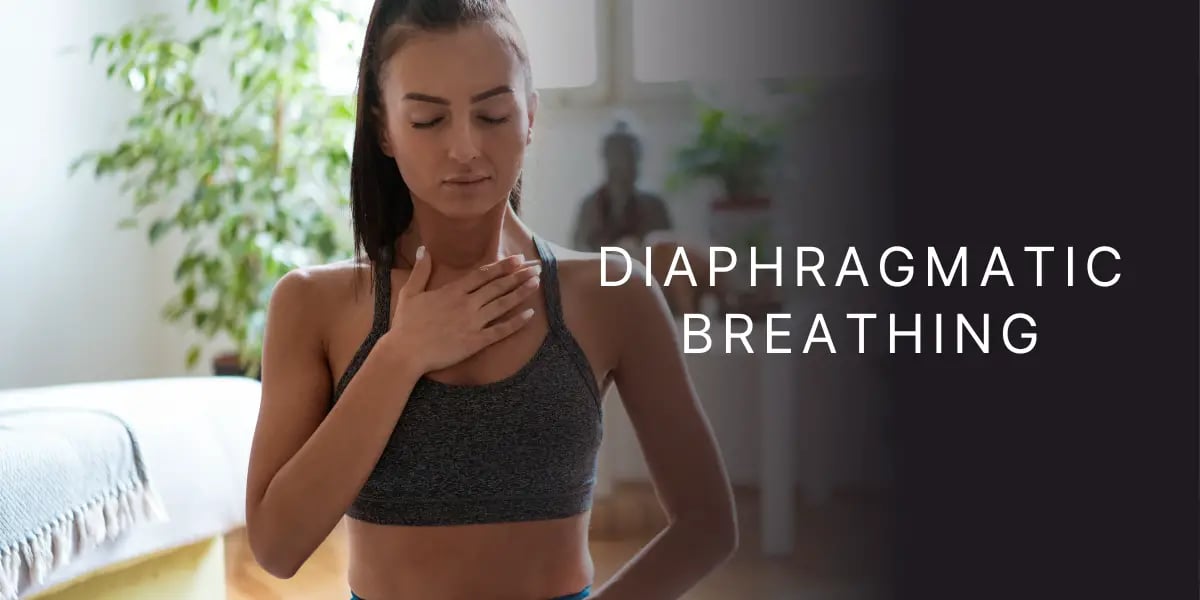Spiritual
Unleash the Power of Diaphragmatic Breathing: Transform Your Health and Boost Your Energy!
In the field of psychotherapy, diaphragmatic breathing is an indispensable tool for unlocking mental blocks and facilitating emotional healing. It has become a vital component in all my practice thus far!
Diaphragmatic breathing is a potent technique that can be utilized to achieve profound physical and psychological relaxation. Performing this exercise can help one feel more at ease, elevate their mood, and even enhance immunity levels–all things which are essential for good health!
Utilizing diaphragmatic breathing is not only an effective means of relaxing but also useful for enhancing vitality and maintaining overall healthiness.
What Is Diaphragmatic Breathing?

Are you curious about the practice of diaphragmatic breathing? This innovative technique can be used to boost your energy and improve overall well-being.
The most common exercise method is chest breathing, wherein one inhales and exhales through one’s mouth. This may induce relaxation for some, but for others, it may leave them feeling tense!
Diaphragmatic breathing is a breath-control exercise in which individuals perform inhalations and exhalations through the abdomen – not just their mouths – to promote greater vitality and well-being. This technique has been hailed as an essential component of yoga and contemplative practices, such as Zen Buddhism; however, its benefits have recently attracted attention from Westerners seeking relief from stress-induced ailments.
Why Is Diaphragmatic Breathing Important?
Diaphragmatic breathing is a quintessential practice for anybody interested in enhancing overall well-being. It provides an accessible, low-effort method for cultivating mental clarity and reducing stress levels, while also helping to prevent potential health problems like anxiety and depression.
The diaphragm is the primary muscle responsible for breathing. It separates the lungs from the abdominal cavity and aids in drawing air into the body while expelling it at the moment of inhalation. Precisely coordinating one’s efforts with this muscle can lead to optimal respiration!
Why Practice Diaphragmatic Breathing?
Effects of Diaphragmatic Breathing on Stress
Diaphragmatic breathing can help reduce stress by activating the body’s natural relaxation response. When practiced regularly, this technique can lower cortisol levels and mitigate the negative effects of stress on the body.
Diaphragmatic Breathing for Healthy Adults
Even healthy adults can benefit from diaphragmatic breathing as it promotes optimal oxygen exchange in the body, improves respiratory function, and enhances overall well-being.
Learning Diaphragmatic Breathing Techniques
Learning proper diaphragmatic breathing techniques involves focusing on engaging the abdominal muscles, inhaling deeply and slowly, and exhaling fully to expel stale air from the lungs.
How to Practice Diaphragmatic Breathing
Diaphragmatic breathing is an effective habit for relaxing the mind and body. After all, it doesn’t take much effort to inhale and exhale – what could be simpler?
This technique is simple yet quite powerful. To commence, sit up straight with your hands at your side. Then slowly inhale through your nose. Once enough air has been taken into your lungs, slowly exhale; relishing in each successive breath as it leaves your nostrils. Then repeat this process once more before concluding with a brief pause for reflection!
To begin practicing diaphragmatic breathing, follow these steps:
- Find a Comfortable Position:
- Lie down on a flat surface with your knees bent and your head supported. You can use a pillow under your knees and head for support.
- Alternatively, you can sit comfortably in a chair with your knees bent and your shoulders, head, and neck relaxed.
- Place Your Hands:
- Place one hand on your upper chest and the other hand on your abdomen, just below your ribcage. This will help you feel the movement of your diaphragm as you breathe.
- Inhale Deeply Through Your Nose:
- Breathe in slowly through your nose, allowing your abdomen to rise. The hand on your abdomen should rise while the hand on your chest remains relatively still.
- Exhale Slowly Through Your Mouth:
- Tighten your abdominal muscles and exhale slowly through your mouth. The hand on your abdomen should fall while the hand on your chest remains still.
- Focus on Your Breathing:
- Concentrate on your breath and the movement of your diaphragm. Ensure that your breathing is slow, steady, and deep.
- Repeat:
- Continue to breathe deeply and slowly for 5-10 minutes, repeating the inhalation and exhalation process.
How to Find Your Core: The Segment Test
The core is the most difficult spot to locate on your anatomy, yet it is not unreachable! In fact, no matter what your age or fitness level may be, you can always locate your core.
The segment test requires a simple hand-to-chest measurement of your body, neck and head dimensions – taking care to include both the ribs and vertebrae as well as the clavicles (collar bones). Afterward, compare the results with those of a companion.
If you notice these measurements in opposition to each other – such as when one person is taller than another – then you have found your core!
Getting Started with Diaphragmatic Breathing
If you’re not familiar with the term, let me clarify:
Diaphragmatic breathing is a form of controlled breathing in which you completely relax and focus on your abdomen. It helps to enhance your overall health while improving your emotional state and alleviating stress too!
The process is simple: direct attention to your diaphragm along the dotted line; simultaneously inhale through your nose and exhale through your mouth. Don’t forget to keep an eye on that waistline as well!
How often should you practice this exercise? Start off with three breaths per minute – about one breath per second – for starters. Then gradually increase it over time if you’d like!
Curious about your own breathing? Get a Profile of Your Breath for Free!
Did you know that your breathing can disclose a wealth of information about your health, behavior, and well-being?
To explore this possibility, delve deeper into your respiration patterns and discover how they relate to issues ranging from overall wellness to stress levels and even mood.
By self-administering a Profile of Breath assessment, users are able to discern their breath pattern; this provides valuable insight into how the activity may be influencing their body in various ways.
Benefits of Diaphragmatic Breathing
Relaxation and Stress Relief
Diaphragmatic breathing serves as a powerful relaxation technique, helping individuals unwind, alleviate tension, and promote a sense of calmness and well-being. Consistent practice can lead to reduced stress levels and improved mental clarity.
Improving Lung Function with Diaphragmatic Breathing
By enhancing oxygen uptake and promoting efficient breathing patterns, diaphragmatic breathing can enhance lung function and increase respiratory efficiency. This is particularly beneficial for individuals with pulmonary conditions.
Impact of Diaphragmatic Breathing on COPD
Individuals with Chronic Obstructive Pulmonary Disease (COPD) can benefit from diaphragmatic breathing exercises as they can help optimize lung function, improve oxygenation, and reduce the symptoms associated with the disease.
Tips for Improving Diaphragmatic Breathing
Practicing Belly Breathing
Belly breathing, sometimes referred to as abdominal breathing, involves focusing on expanding the abdomen during inhalation to engage the diaphragm and promote deep breathing fully. This technique can improve oxygen flow and relaxation.
Engaging Abdominal Muscles during Breathing
Engaging the abdominal muscles during breathing helps strengthen the diaphragm and promotes efficient breathing mechanics. By keeping the chest still and focusing on abdominal movement, individuals can optimize their breathing technique.
Importance of Inhaling and Exhaling Slowly
Inhaling and exhaling slowly during diaphragmatic breathing is essential for maximizing the benefits of the technique. Slow, controlled breathing allows for better oxygen exchange, relaxation, and stress reduction.
Conclusion
Diaphragmatic breathing is a potent tool for enhancing your overall health and well-being, both inside and out. It can be employed as a daily practice for attaining greater vitality and equanimity; or utilized intermittently as an effective stress management technique when required.
Once you master this breathing technique, you can unleash its immense power and transform your life!

